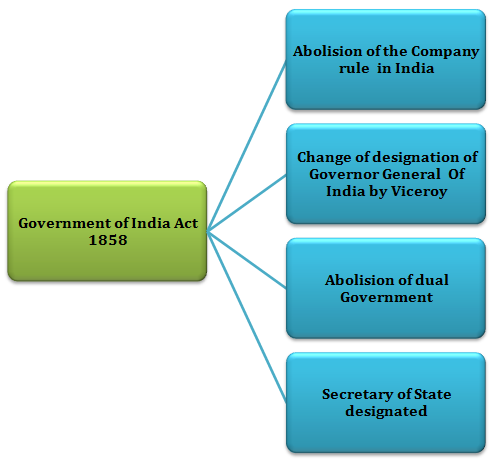

The Government of India Act 1858 was the first act that applied under direct British rule. After the 1857 revolt, The British government decided to take over the rule of India from the Company. A bill was passed in 1858 in British Parliament to fulfil this agenda and this act was also called the Act for Better Government of India. The British government appointed Lord Canning as the Governor General of India during this act’s enactment.
The Parliament of the United Kingdom passed the Government of India Act on 2nd August 1858. The control of the administration of British India was handed over to the Crown by the British Parliament and in this bill; they referred to the defect that existed in the system of the Indian Government. This act was introduced as a bill by Lord Palmerston and the Prime Minister of the United Kingdom.
Lord Palmerston was forced to resign for other issues before the theorised bill was passed. The first State Secretary of India, Edward Stanley introduced this bill during the 15th earl of derby where it is said that this act was created for the improved Governance of India.
The Sepoy mutiny ended in the year 1858 that sends great shockwaves throughout London. It gave stimulus that the company should not have authorization for trading and continue as a political power. Many British settlers and traders had increased their enthusiasm for India since 1853 and their constant objection that their interest was neglected by the company. Prime Minister Palmerston, said the cumbrous and irresponsibility, irrational, complex characteristics of double government were the basic error in the rule of the Company.
The Act was approved on August 1858 by the Parliament after a month when Lord Canning proclaimed the victory of the army of the British. British dominance transferred over India from the Company of East India which was highly accused of rebellion against the Crown. The Crown rule suspended the Company rule in India and the State Secretary for India was created as an exercise of the power of the British Crown.
The Company of East India lost their control over the territory of India and British Indian territory was governed in the British queen’s name. This 1858 Act transform India into an immediate British colony. The civil services of India were established to help the Indian administration to function very smoothly. Indians were admitted to the service according to the provision (Wu, 2021).
This 1858 Act brought an end to the concept of lapse and demolished the double government that was proposed by Pitt as the India Act of 1784.

The Board of Control and the Courts of directors of the British East India Company was damaged completely. The power of the Court of directors of the Company was totally transferred and settled in the Secretary of State for India and Lord Stanley was appointed as the first Secretary of State for India. A Council that consisted of 15 members assisted the Secretary of State. That council only had a role as an advisor and the chairman of the council was the Secretary of State for India.
He was also acting as a medium of communication between the Indian Administration and the British government. The Secretary of State for India would have full control and authority over the administration of India and he also was blessed with the power that he could secretly dispatch an army to India without discussing it with his council. The British Parliament has the authority to question the secretary of state about the affairs of the states in India.
The Viceroy and Governor General of India was the agent of the British government. Crown appointed the Viceroy and the Governor of the different presidencies.
An Executive Council assisted the Viceroys. It was pronounced that the rest Princes of India would be provided with their complete independence status if they acknowledge British rule. Crown would accept the apology of every Indian who joined in the Sepoy mutiny excluding those who killed the subjects of the British.
The Government of India Act 1858 had also some defects that are −
There was no representative of the Indian people and India was completely dominated by the control of the Imperial.
The Secretary of State was the highest power and had the free hand on the administration of India and he was only answerable to the British Parliament.
The 1858 Act stated the transfer of the power of India to the Crown from the East India Company. With this act, the Company ceased as a political company and the rule of the Company in India was ended. Therefore the Colonial System of government changed into Imperial rule under the Crown. At that time the queen of the British was Queen Victoria and she had the responsibility for the administration of British India.
Q.1. What was Sepoy mutiny?
Ans. Sepoy mutiny was a revolt that started on 10th May 1857 by the soldiers of Indians. The main reason behind this mutiny was the cartridge of Enfield’s rifle had to bite off by the soldiers before loading the gun. The soldiers of India thought that the cartridge was made with either the fat of a pig or cow and this was opposite to the sentiments of Muslims and Hindus. Therefore they denied using the cartridge and this began the protest against the British.
Q.2. Who was the first Viceroy of India?
Ans. Lord Canning was appointed as the first Viceroy of India in the year 1858 and his duty ended in 1862. They were the General Governor of India who represented the Crown in India.
Q.3. Who was the last Viceroy of India?
Ans. The last Viceroy of India was Lord Mountbatten and he was appointed in 1947. He was also the first Governor General of Independent India.